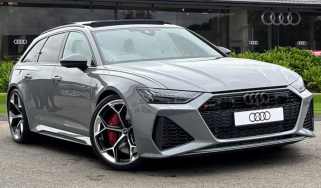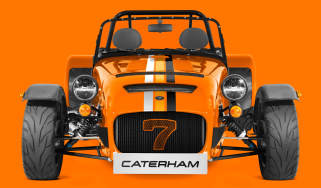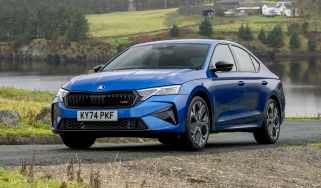Pagani Zonda F Roadster
John Barker recreates the best drive of his life with a Zonda F in Tuscany
Twenty years, hundreds of cars, tens of thousands of miles, and out of all that, just one drive I consider perfect. There’s clearly a slice of luck involved, though I have to say that when you’re driving a Pagani Zonda C12 in the Val d’Orcia in southern Tuscany, you need only a very thin slice of luck.
It was eight years ago and we were there with six supercars, putting together ‘The Test’ for issue 022. Late one afternoon we were convoying over to the cover shoot location, and as we reached the turning for the gravel road along which we’d have to travel to get there, everyone duly turned left off the main road, except me. I couldn’t help it, I simply had to have more of this Zonda, to scratch the itch, so I carried straight on and made a 30km loop, figuring they’d be a while setting up the shot. It was heaven; an extraordinarily beautiful and challenging road, its surface still warm from a day in the sun, and in my hands was the most involving and responsive supercar of all, considerately, tenderly wrung out.
It was a unique experience, a sublime moment that I have treasured ever since. Unrepeatable? Almost certainly. Not even worth trying? Affirmative. Or so I thought, until we managed to negotiate a drive in the last ever Zonda F, which would be transported from the factory to a location of our choice, within reason. And there seemed no good reason for that location not to be the best driving roads we know in Italy – the roads of the Val d’Orcia.
More reviews
Such a venture comes with risks, the overriding and very obvious one being that, even though it’s a Zonda in the Val d’Orcia, it won’t be a perfect drive and the cherished memory of the one that was perfect might be sullied. And there was every chance of dreadful weather, this being early December. I weighed up the risks and considered them worth taking. I know, I know: brave and selfless. Yet I had a gut feeling that things would go right.
Almost immediately, they started to go wrong. As photographer Matt Vosper and I settled into our seats for our Ryanair flight to Pisa, we were informed that, due to fog, we wouldn’t be going to Pisa but would be landing at Genoa, 200km short, at midnight. Once there we spent two hours in a coach, followed by half an hour in a taxi queue. Vosper and I have barely warmed our hotel beds before we’re in another taxi heading back to Pisa airport to pick up our hire car and hit the road for southern Tuscany.
Not a great start, then, and it isn’t getting better. ‘You can shoot a car in any weather apart from fog,’ says Vosper. We’re within half an hour of our rendezvous point and it’s still not cleared. But moments later we round a bend in the A1 and the scene is crystal clear, the sun burning bright in a cloudless sky, the rolling scenery unmistakably Tuscan. We’re in business.
Well, I am. Just off the A1 junction for Chuisi, we meet up with Simone Tarozzi and Claudio Sotgiu from Pagani and lay our eyes on the Zonda. ‘It’s black,’ says Vosper, as if answering the unasked question ‘What would be the hardest colour to photograph in this harsh, late-morning light?’ It’s not painted, though, but is finished in perfect, lacquered carbonfibre – Pagani has always worked this material better than anyone else.
We’re deeply indebted to the owner of this 1 million euro car, which was finished earlier this week and is due to be delivered tomorrow. It has just 5km on its odometer and we’ve agreed to add no more than 100km, which is just fine because the route we have planned is around 50km. Simone will warm it up, so I hop into the passenger seat for the short run up to the town of Sarteano, our start point. He thumbs the starter button embedded in the top of the gearlever, the starter whirrs like a drill, the 7-litre AMG V12 catches and the memories come flooding back.
We set off up the smooth, switchback-laden road and even from the passenger seat the Zonda feels right; supple yet intimately connected to the tarmac, sensitive to steering and throttle inputs, but relaxed, calm. Same as it ever was.
There’s a bit of bustle about Sarteano on this bright December morning, and the arrival of the glinting, crooning Zonda adds a bit more, a small audience gathering as Simone flips the rear bodywork open and disassembles the roof.
My turn. The first surprise is that the steering feels very heavy, like a power-steered car with the ignition off. Simone explains that this is an optional tune for the owner, who intends to take the car on track and prefers to have more weight at the wheel to work against. It changes the feel of the car, so it’s handy that the first third of the route, heading due south out of Sarteano towards Radicofani, offers an ideal warm-up. It’s a winding, moderately paced road that allows you to get the measure of a car, to get used to its controls and experiment with throttle, steering and brake inputs to get a feel for its grip and balance, the way its weight shifts around, how it reacts.
I’m smiling because, against the odds, the day is already taking on a lustre of perfection. The warm sun is set in a pristine azure sky and the road is meandering invitingly through woods. There are sections with rhythmic, wrist-rolling left-right-lefts where the Zonda hooks deliciously, grainily into alternate cambers, and longer links of faster corners that can be strung smoothly and effortlessly together on the throttle alone, the big V12’s note swelling magnificently at the 3000rpm threshold and producing a random barrage of powdery explosions as it hauls off speed on the overrun. It’s almost as if the car is breathing along the road.
The hair on the very top of your head is the only thing ruffled in the open cockpit and you feel perfectly placed to appreciate what the car is doing. The comfortable, firmly padded seat is no race bucket, but somehow holds you almost as securely, while the part-leather, part-wood flat-bottomed steering wheel also works far better than you expect. Through wheel and seat this most organic of supercars reveals its intent with clarity. Lean on the front into a tight turn and the way the steering lightens fractionally and the subtle nibble of tread blocks describes the limit. Similarly, a good squeeze of throttle just past the apex hunkers the tail down, smears the fat rear tyres against the asphalt and points up how things will go if you get more ambitious. Gorgeous.
In all senses, this is a great place to be. Halfway to Radicofani you round a corner and the view is typically Tuscan, with a long avenue of cypress trees lining a driveway off to the right. It’s almost too good to be true, like a scene created for a movie. Thing is, it just gets better and better from here.
A few kilometres further on you’re out of the woods and the elevation is revealed. Deciduous trees leaved in brown and gold blanket the sides of the valley below, while on the distant hilltop there’s the crisp outline of the tower at Radicofani, perched there like a chess piece. We’re not going that far, though. We hook an acute right at the next crossroads, signed for Pienza, and plunge downhill into the trees once more and a chilly shade. The gradient lessens as we reach the valley floor, wooded hills give way to gently undulating farmland and we’re now in the Val d’Orcia proper.
The first time I found myself on this road I laughed out loud, unable to believe how beautiful, how empty and challenging it was. If an electronic games company made up a Tuscan road it would look like this and you’d scoff at what a pastiche it was, but it’s for real, and my heart lifts to be back. Intermittently ancient cypresses line the road, standing to attention, like a guard of honour. On either side the light earth of the undulating fields is tilled so carefully that from a distance it appears to have been raked like pea gravel in a Japanese Zen garden. Within a few kilometres we come across the first farm, built on the top of a small hillock from light stone capped with shallow-sloping terracotta-tiled roofs and garnished with a cypress-lined winding driveway. It’s almost impossibly photogenic and romantic, a postcard-perfect Tuscany. And there is no traffic here. You’ll see a car maybe every ten minutes because there are no towns or villages all the way to Pienza, some 20km distant.
You need to concentrate hard early on. This is a fast, decent-sized road, often tacking sharply without warning up into the gradient and then curving down again, trees obscuring the line. As it goes on, the road unravels and gets really fast, and the Zonda can start to stretch its legs. There’s a generous 641bhp on offer and even though we won’t be exploiting every last one today, in deference to its freshness, we have access to considerably more than the original C12 had. It sounds absurd, but the first Zonda had just 389bhp from the regular Mercedes 6-litre V12 (the 555bhp AMG 7.3-litre C12S was imminent). Yup, the supercar that gave me my perfect drive had less than 400bhp, and it didn’t matter because it weighed 400kg less than other supercars like the Diablo.
It’s still one of the lightest supercars today. Snap open the 641bhp Roadster F’s throttle and that lack of inertia is even more apparent, the car lunging forward seemingly before the pedal has hit the stop. Mind, to fully appreciate what’s happened you need another, heavier supercar behind. High gears are fun, too, especially if you want to explore the V12’s wonderful vocal repertoire in detail, from the heavy, churning, guttural pulse close to idle, through the sudden and shockingly open-throated bellow at 3000rpm, to the frantic yowl as the V12 keens to 7000rpm. Though to be honest, when the engine kicks for the red line the shove is so shocking that you’re not paying much attention to the sound it’s making. Thank heavens the F’s carbon-ceramic brakes are simply sensational, as good as any I’ve tried, the lack of mass probably helping here too.
It’s not just the brakes that slow you down on this road, though. You’ll round a corner, feeding in the power as it opens out, the road will straighten and spear towards the horizon… and your foot will lift from the throttle involuntarily. At the same time ‘wow’ forming on your lips as you take in the view: pines lining the road on both sides, their bushy tops forming a dark canopy, the late afternoon sun from the left making it look like you’re driving down a piano keyboard. Turns out backing off is prudent anyhow, the surface being pretty choppy under the trees, possibly because their roots are growing beneath it.
Gradually the road gets straighter and faster, but that changes when you get to the third crossroads and turn right for Pienza. I clearly recall driving these last few kilometres on ‘The Test’ because I was wringing everything from a Ferrari 550 to stay in touch with Dickie Meaden in a Ferrari 360, who was in turn extracting every last ounce to keep up with Harry in a 911 Turbo. Despite the furious pace I remember being distracted by the astonishing sight of Pienza. Bathed in the late afternoon sun, this hilltop town, built along an outcrop overlooking the Val d’Orcia, cost me a couple of car lengths.
The winter sun is heading for the horizon and the Zonda’s heater is on maximum output as we crest the last rise today and catch sight of Pienza. It’s the most stunning I’ve ever seen it, glowing a warm gold in the soft light. It’s an evocative end to a wonderful drive and reiterates that we’ve had a generous slice of luck today. A perfect drive? Not very far off it, not far at all.
Just how lucky we’ve been is obvious the next morning when we step out of our Pienza hotel into a downpour. Yet still the view out across the valley is compelling. Fact is, you don’t need a brilliantly sunny day or a fabulous supercar to enjoy the splendour of the Val d’Orcia. But I’d be lying if I didn’t admit that they’re pretty useful if your goal is the perfect drive.
Specifications
| Engine | V12 |
| Location | Mid, longitudinal |
| Displacement | 7291cc |
| Cylinder block | Aluminium alloy |
| Cylinder head | Aluminium alloy, dohc per bank, four valves per cylinder |
| Fuel and ignition | Electronic engine management, sequential multipoint injection |
| Max power | 641bhp @ 6200rpm |
| Max torque | 575lb ft @ 4000rpm |
| Transmission | Six-speed manual gearbox, rear-wheel drive, limited-slip differential |
| Suspension | Double wishbones, coil springs, dampers, anti-roll bar front and rear |
| Brakes | Ventilated carbon-ceramic discs, 380mm front and rear |
| Wheels | 9 x 19in front, 13 x 20in rear |
| Tyres | 255/35 ZR19 fr, 335/30 ZR20 rear |
| Weight (kerb) | 1230kg |
| Power/weight | 529bhp/ton |
| 0-62mph | 3.6sec (claimed) |
| Top speed | 214mph (claimed) |
| Basic price | 1 million euros |
| On sale | Not any more! |
| evo rating | 5/5 |




